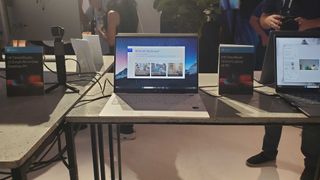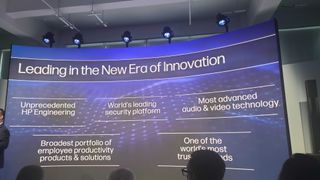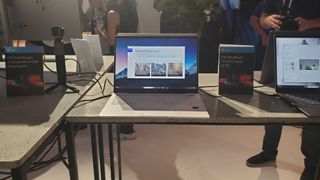Recently I attended an HP Imagine AI event, which covered the full scope of the tech giant’s plans for AI in both its software and hardware. This was one of many recent events, showcases, and hands-on from numerous manufacturers who are clamoring to show media and buyers what it can offer in this increasingly overcrowded market.
While HP’s offerings were quite interesting and often seemed quite useful, this all poses a much larger question: what is the purpose of all this? A second question must be begged afterward: what is the true future for AI? Once you unravel all the glam of these AI events, the shiny new AI PCs, and the multitude of AI-powered software and tools, this is the foundational question left.
After ruminating on it for a while, I believe I found my deceptively simplistic answer: accessibility—a simple answer, but a truly profound one that draws out AI’s true potential.

What did HP reveal?
HP first delved into its mission statement regarding AI — to make AI real it must be tangible, show HP’s leadership, and catalyze the industry. The manufacturer also made it clear that one of its main goals would be to address audience concerns regarding trust and establishing a verification system in AI models. It also needs to address issues such as hallucination, drift, and bias in its AI data sets. Whether or not HP can live up to these ideals will be left to the test of time, however.
One of the main reveals was the HP OmniBook Ultra 14, which offers an AMD Ryzen AI 300 SoC with 55 TOPS NPU, even higher than AMD’s standard 50 TOPS NPU, and part of the collaborative efforts between AMD and HP. It was also stated to be 45% more powerful than Apple’s M4 chips. It’s a bold claim and one without specifics like benchmark tests to back them up, but if it holds remotely true then we could be looking at a truly incredible machine.
Lastly, HP revealed AI software and tools that will be taking advantage of the built-in AI. Zoom, for instance, noticed that 40& of users use fake backgrounds so it improved its image quality while eliminating item disappearance to make for more of a seamless look. Two editing programs, Djay Pro and Blackmagic Design, allow for in-depth depth music and video editing tools that beginners can use. There’s also Loccus.ai, a safety and trust AI tool that uses a Trojan neuro network that combats audio deepfakes, which are some of the most deception and fast-evolving types.

Accessibility is what AI was made for
The two most promising AI programs I witnessed, were both accessibility-based. Cephable is similar to Google’s own Help Me Hands-Free tool, as it provides face tracking, head tracking, and voice inputs through speech recognition. This allows for alternative navigation methods for those who cannot use a keyboard and trackpad or mouse. Due to this tool running through the AI-powered NPU, it frees up the processor and graphics card for other processes.
OmniBridge is an incredibly useful tool currently in development, targeting an unfortunately niche and underserved market. This program translates sign language into both spoken language and text at the same time, which is made possible through the use of AI analyzing 3D space to interpret gestures in real-time. While the program is still in Alpha, it already knows 5,000 signs, with the ultimate goal of learning 10,000 or full fluency.
It’s not hard to see what kind of potential these two programs hold. Not only on their merit but in terms of what other kinds of accessible programs could be created with AI. I would love to find even more of these AI tools developed in the future, it’s truly exciting to see what can be done with tech for the greater for once, rather than for solely profit.

Final thoughts
We’re seeing AI sweeping through the tech industry at an accelerated pace, with every tech giant creating their own AI-based software and hardware to take advantage of the trend. Of course, as with many other recent advancements in technology, it comes at an incredible ecological cost. AI runs out of large data centers needed to power both generative AI and the cloud storage it often relies on, which has been consuming massive amounts of water and other resources.
There’s also the major plagiarism issue, with AI being trained on copyrighted music, papers, written works, research, art and photos, and more. And unfortunately, while laws are being developed to combat this issue, creatives and journalists are still being pushed out of their industries in favor of companies using these AI tools to create content instead.
However, AI has never been all bad, and even now there are ways to apply it to help those in need of these tools the most. From what I saw during HP’s Imagine AI event, the accessibility programs were by far the most creative and helpful of the bunch. They addressed real-world issues and demonstrated why AI is necessary to fix them, using the power of AI to aid underserved markets. Not to mention that this same tech can be run without interfering with other PC processes, meaning you can continue your productivity and creative work or even gaming while having these accessibility tools aid you simultaneously.
If we need to suffer a world that’s oversaturated with AI, with much of it actively harming others and the planet, the only use I want to see is that which genuinely helps others instead. Fewer tools about how to spy on workers using their cell phones in Zoom calls and more tools that translate sign language into multiple spoken languages.
Services Marketplace – Listings, Bookings & Reviews
